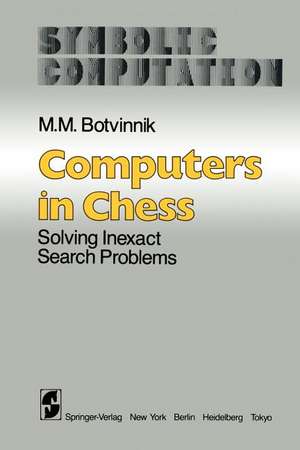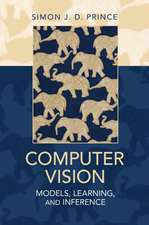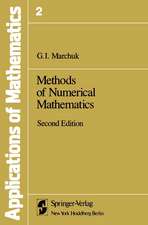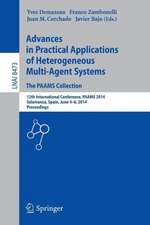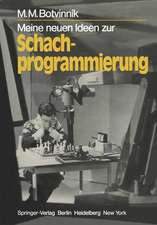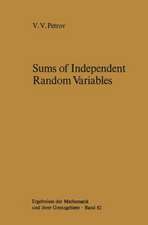Computers in Chess: Solving Inexact Search Problems: Symbolic Computation
Autor M. M. Botvinnik Traducere de A. A. Brown Contribuţii de A. I. Reznitsky, B. M. Stilman, M. A. Isfasman, A. D. Yudinen Limba Engleză Paperback – 26 sep 2011
Din seria Symbolic Computation
- 20%
 Preț: 350.21 lei
Preț: 350.21 lei - 20%
 Preț: 651.89 lei
Preț: 651.89 lei - 20%
 Preț: 647.61 lei
Preț: 647.61 lei - 20%
 Preț: 649.09 lei
Preț: 649.09 lei - 20%
 Preț: 648.44 lei
Preț: 648.44 lei - 20%
 Preț: 639.35 lei
Preț: 639.35 lei - 20%
 Preț: 653.06 lei
Preț: 653.06 lei - 20%
 Preț: 642.19 lei
Preț: 642.19 lei - 20%
 Preț: 651.09 lei
Preț: 651.09 lei - 20%
 Preț: 659.97 lei
Preț: 659.97 lei - 20%
 Preț: 645.31 lei
Preț: 645.31 lei - 20%
 Preț: 648.44 lei
Preț: 648.44 lei - 20%
 Preț: 650.27 lei
Preț: 650.27 lei - 20%
 Preț: 646.47 lei
Preț: 646.47 lei -
 Preț: 394.29 lei
Preț: 394.29 lei - 20%
 Preț: 342.28 lei
Preț: 342.28 lei - 20%
 Preț: 339.99 lei
Preț: 339.99 lei - 20%
 Preț: 641.01 lei
Preț: 641.01 lei - 20%
 Preț: 657.99 lei
Preț: 657.99 lei - 20%
 Preț: 648.26 lei
Preț: 648.26 lei - 20%
 Preț: 661.47 lei
Preț: 661.47 lei - 15%
 Preț: 638.89 lei
Preț: 638.89 lei - 20%
 Preț: 657.67 lei
Preț: 657.67 lei - 20%
 Preț: 652.73 lei
Preț: 652.73 lei - 20%
 Preț: 330.42 lei
Preț: 330.42 lei - 20%
 Preț: 709.98 lei
Preț: 709.98 lei - 20%
 Preț: 834.69 lei
Preț: 834.69 lei - 20%
 Preț: 656.03 lei
Preț: 656.03 lei - 20%
 Preț: 324.64 lei
Preț: 324.64 lei - 20%
 Preț: 757.48 lei
Preț: 757.48 lei - 20%
 Preț: 355.67 lei
Preț: 355.67 lei - 20%
 Preț: 328.27 lei
Preț: 328.27 lei - 20%
 Preț: 330.24 lei
Preț: 330.24 lei - 20%
 Preț: 342.96 lei
Preț: 342.96 lei - 20%
 Preț: 555.53 lei
Preț: 555.53 lei
Preț: 326.46 lei
Preț vechi: 408.07 lei
-20% Nou
Puncte Express: 490
Preț estimativ în valută:
62.48€ • 64.99$ • 51.58£
62.48€ • 64.99$ • 51.58£
Carte tipărită la comandă
Livrare economică 15-29 aprilie
Preluare comenzi: 021 569.72.76
Specificații
ISBN-13: 9781461297369
ISBN-10: 1461297362
Pagini: 176
Ilustrații: XIV, 158 p.
Dimensiuni: 155 x 235 x 9 mm
Greutate: 0.25 kg
Ediția:Softcover reprint of the original 1st ed. 1984
Editura: Springer
Colecția Springer
Seriile Symbolic Computation, Artificial Intelligence
Locul publicării:New York, NY, United States
ISBN-10: 1461297362
Pagini: 176
Ilustrații: XIV, 158 p.
Dimensiuni: 155 x 235 x 9 mm
Greutate: 0.25 kg
Ediția:Softcover reprint of the original 1st ed. 1984
Editura: Springer
Colecția Springer
Seriile Symbolic Computation, Artificial Intelligence
Locul publicării:New York, NY, United States
Public țintă
ResearchCuprins
1 The General Statement.- Definition of an Inexact Task.- Inexact Tasks and Control Systems.- Two Methods for Solving Inexact Problems.- The Goal of the Game and the Scoring Function.- Goal and Prognosis (The Optimal Variation).- Multi-level Control Systems.- Types of Multi-level Systems.- Advantages of the General Goal.- The Method for Connecting the Optimal Variations of the Components for Types C and E Regimes.- Computer Programs and Humans.- The Expansion of Artifical Intelligence.- 2 Methods for Limiting the Search Tree.- Truncation.- The Goal of an Inexact Game.- The Scoring Function.- Breaking Off a Variation.- The Pruning of Branches.- The Horizon.- Two Trees: The Mathematical Model (MM).- The Stratification of the System.- Three General Limitation Principles.- Improving the Results of a Search.- 3 The Search for a Solution and Historical Experience.- The Search for a Solution by Association.- The Handbook Method of Searching.- 4 An Example of the Solution of an Inexact Problem (Chess).- A. The Search for a Move in an Original Situation.- B. The Use of Historical Experience.- 5 Three Endgame Studies (An Experiment).- 6 The Second World Championship.- KAISSA-CHESS 4.6.- Conclusions.- Appendix 1.- Fields of Play (by B. M. Stilman).- 1. The Formation of Fields and the Search Within Them.- 1.1. The Concept of a Field.- 1.2. The Search Procedure in the Initial Position.- 1.3. The Formation of Fields During the Search—An Example.- 1.4. Formation of a Field.- 1.5. Storage of Information about Sheaves of Trajectories in Computer Memory. Linked Lists.- 1.6. Information on the Trajectories of a Field.- 1.8. Computing the Length of a Denial Trajectory.- 1.9. Correction of the Sighting Method.- 1.10. The Pseudosearch.- 1.11. The Extent of the Climb Up a Branch in thePseudosearch.- 1.14. Freezing a Trajectory for Lack of a Connection to an Active One.- 1.15. Criteria for Freezing.- 1.16. The Algorithm for Freezing.- 1.18. Trajectory and Field.- 2. The Choice of Moves in an Ensemble of Fields (The Mathematical Model).- 2.1. The Goal of the Game and the Ending of a Variation.- 2.2. The Criteria for Breaking Off a Variation in the Search.- 2.3. Testing the Criteria for Ending a Variation.- 2.4. Pruning Branches by the Minimax Principle. On the Branch-and-Bound Method.- 2.5. Pruning Branches by the Worst Case Method.- 2.6. Priority of Moves in a Search.- 2.7. Analysis of the Trajectories of a Sheaf for Inclusion in the Search.- 2.8. Analysis of Trajectories for Forking.- 2.9. Retreat and Deblockade.- 2.10. Pruning in the Presence of Branching in a Sheaf of Trajectories.- 2.11. The Structure of the Search Tree.- 2.12. A New Content of Known Procedures.- Appendix 2 The Positional Estimate and Assignment of Priorities (by M. A. Tsfasman and B. M. Stilman).- Appendix 3 The Endgame Library in PIONEER (Using Historical Experience by the Handbook Method and the Outreach Method) (by A. D. YUDIN).- 3.1. Introduction.- 3.2. Formulation of the Problem.- 3.3. Configurations.- 3.4. The Boundary Effect. Decomposition Formulae.- 3.5. Symmetries.- 3.6. The Structure of the Library. Classes. Coding of the Information.- 3.7. Organization of the Information in the Form of Two-Dimensional Tables with Subordination of Entries.- 3.8. The Algorithm for Using the Endgame Library (The Search for Exact Coincidence).- 3.9. Examples of the Operation of the Subroutine for Using the Endgame Library.- 3.10. Outreach for a Library Position.- 3.11. The Search for Nearby Positions.- 3.12. Filter with Respect to the Pawn Structure.- 3.13. The “One Color-DifferentColor” Filter.- 3.14. Filters Within a Set of Positions.- 3.15. Finding a Group of Neighboring Positions.- 3.16. Implementation of the Outreach Method. Anti-outreach.- 3.17. Entry from the Move-Search Routine.- 3.18. Outreach and Exact Coincidence.- 3.19. The Potential for Wide Use of Library Rules in PIONEER.- 3.20. The Breakoff Criterion Based on the Rule of the Square.- 3.21. Conclusion.- Appendix An Associative Library of Fragments (by A. I. Reznitsky and A. D. Yudin).- References.- Glossary of Terms.- Index of Notation.
